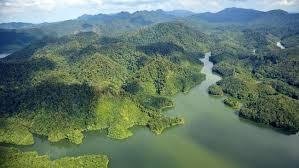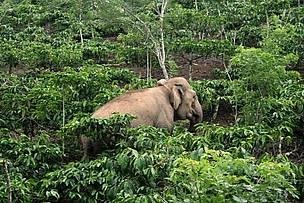Viewing Forest In Indonesia

Forest area in Indonesia shrink every year. The Ministry of Forestry noted that forest destruction to 2009 reached more than 1.08 million hectares per year. Decrease from previous year's forest damage data to more than 2 million hectares per year.
The rate of forest destruction has had a broad impact on the economy. As reported by the BBC's Sri Lestari in West Kalimantan, forest destruction is due to oil palm expansion.
From the thick air of the forest in West Kalimantan we can still see, but amongst the dense tropical forest, we can also see the location like a field that is just overgrown with grass without large trees.
Data from the Ministry of Forestry mentioned that in addition to Sumatra, Kalimantan forest has a large rate of damage, of total forest damage that occurred in Indonesia of 1.08 million hectares per year according to.
This forest destruction is recognized by the Minister of Forestry Zulkifli Hassan causing the condition of Indonesia's forests is critical.
'' Indeed I categorize Indonesia's forests in a critical condition, because decades become a mainstay for income for the country. Of the 130 million only 43 million fall into the virgin forest category ''.
"The production forests that were once managed by logging concessions now stands at about 48 million in critical circumstances, then 40 million other forests disappear," Zulkifli said.
However, the latest data from the Ministry of Forestry claimed that the rate of forest destruction indicates a downward trend compared to previous years.
But Greennomics environmentalist says there is no definitive data on forest destruction in Indonesia. As the Director of Greennomics Elfian Effendi said.
"It is difficult to know how much the deforestation rate in Indonesia is, because the latest data is based on satellite imagery in 2005 or has expired, so how can forest destruction decline?
Kalimantan is one of the areas that has the largest natural forest. In 2007, in the State of the World's Forests report, FAO (Food and Agricultural Organization) placed Indonesia in 8th out of ten countries with the largest natural forest area in the world.
But the rate of forest destruction in Indonesia reached 1.87 million hectares in the period 2000 - 2005, resulting in Indonesia being ranked 2nd of ten countries, with the world's highest rate of damage.

Economic impact
Zulkifli Hasan
Image caption
The Minister of Forestry acknowledges the condition of Indonesia's forests is critical
Zulkifli said the peak of forest destruction began to occur around the year 1999-2002, caused by illegal logging, forest fires and also the expansion of the region.
'' First of all because of illegal forest clearing into oil palm plantations, becoming agriculture and illegal mining, secondly due to illegal logging, third due to forest fires associated with local culture. These three things are accelerating the destruction of our forests ''.
Zulkifli added the expansion of the region in Kalimantan also exacerbates forest destruction. The Ministry of Forestry said that currently there are 500 districts in Kalimantan from the previous 200 and the expansion of this region took the forest area.
Meanwhile, the Alliance of Indigenous Peoples Nusantara AMAN West Kalimantan further highlighted the problem of oil palm expansion as the main cause of forest destruction.
'' Provide great opportunities for palm oil investment from center to provincial to district level. Unfortunately this development is without control, much development of oil palm plantations that ignores environmental impact analysis or AMDAL, while it is actually a prerequisite. This is a support for forest destruction, "said Surjani Aloy from AMAN Kalbar ''.
Alloy said the destruction of forests, especially in West Kalimantan, eroded the culture and economics of the Dayak people who had been relying on life from trees in Borneo forests.
Globally forest destruction also has an economic impact. A study at the World Resource Institute shows that Indonesia's economic growth fell by 40-60%, when calculated based on the loss of money arising from the environmental sector.
Director of Greennomics Elfian Effendi explains the economic sector that must get forest ecological support, he took the example in Java.
'' This output can not be achieved if it does not have the support of forest ecology, there is no support from a good watershed, so we can see that the amount is supported by the economic output of Java from the agriculture sector, the processing industry, electricity and clean water 963 , 71 trillion per year ''
Meanwhile in Sumatra and Kalimantan with an area of 100 million hectares, the rate of forest destruction in two islands is equivalent to twice the island of Java or 30 million hectares. Though the contribution of forest ecology to a number of economic sectors is quite large in these two islands.
'' We see from the sector directly from the contribution directly affect the contribution of forest ecology that is agriculture, electricity processing and water besrih. The output value reaches RP 386.06 trillion per year, this is for Sumatra alone, if Kalimantan is only Rp 78.46 trillion per year ''

Forest exploitation
Kalimantan forest
Image caption
Green economy is needed to preserve the forests of Borneo
Greenpeace environmental organizations mention for 30 years, the pattern of development of Indonesia so far is the exploitation of the forestry sector for palm business, paper and pulp, mining, and others.
Such a pattern of development makes the rate of deforestation increasing in Indonesia.
To prevent this, the government must change the pattern of development by considering the ecological side, as stated by Joko Arif, Green Peace Campaigner in the forest area.
'' The pattern of development in the forestry sector is more toward suistanability or green economy. Of course in the short term there is an opportunity cost that must be lived ''.
"The government must go on, because this opportunity only appears once, because once our forests run out there is no other way, then in our opinion in the short term there is an opportunity cost but in the long run, the profits will double because not only gain profit economic but also ecologically, "added Joko Arif.
Green Peace's Joko Arif said the opportunity to change the policy pattern came with the signing of a $ 1 billion moratorium-the temporary suspension of deforestation in Oslo Norway, late May.
But it takes a great political will to run the deal
that's all I can say
Thank you very much